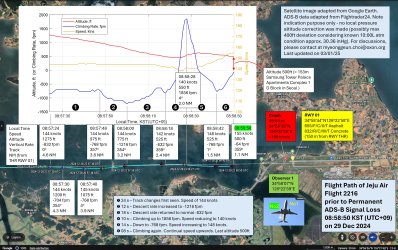So would it be fair to sum up what we "know" as -
- for some reason the power was lost to both the CVR and data recorder about 5 minutes before the emergency landing, but that couldn't have been caused by both engines shutting down or being shut down because after the recorders lost power the pilots elected to go around and still regained altitude and then completed the turn and landed? I guess the other interesting thing is that from all information we have - the recorders both stopped some seconds before the pilots decided to go around - and obviously the pilots had sufficient confidence in the engine(s) at the decision point or they wouldn't have gone around.
Loss of both generators pretty much has to be tied with engines. But, it cannot possibly have happened before the GA, as you simply cannot go around without them. Well, not for long enough, anyway. From the point where data is lost on the approach, the aircraft barely had enough energy to continue straight ahead to the runway. Think BA 38. The berm may well have still been hit, but from the other direction. The upshot is that we appear to have contradictory information, which probably means that it's wrong.
Possibly may not have considered/expected the huge float that occurred for quite some distance down the runway either - if that hadn't of occurred then the solid object in the overrun may not have even come into play.
The entire glide approach thing would never have been practiced (in the 737 sim). They may have had a go, just out of curiousity, but it never would have been practiced to proficiency, and the 'numbers' would not have been in the manuals. If you don't know exactly how much height you'll need for the turn, and are making it up on the spot, then the entire process becomes one that involves more than a little luck. My figure of 2,000' is just a guess, basically more than a Macchi, but less than an A-4.
I don't think there was ever any chance of it stopping on the runway, even if he'd managed to land in the first 1,500'. The other examples we've had of aircraft like this doing gear up landings (757 & 767) have both used up large amounts of runway, and they were both configured with normal flap, and so their speeds were much slower.
Apparently 4min before impact
But I'd like to see the actual timeline.
You and me, both.
The ADSB, CVR and FDR all powered from the AC electrical bus - ie powered by the engine generators.
Probably off different buses, too.
Where is the data for that? Last recorded altitude on ADS-B was 900 feet. An unpowered aircraft can gain altitude at the cost of airspeed - you don't necessarily need engine power to go higher. What was the highest altitude in the GA.?
900' a couple of miles short of the runway, gear and flap out, and at a speed of around 150kts. That just doesn't get you to the other end at the better part of 200kts, and clean. EK was in about the same configuration, and they didn't go far. Energy has to have been added along the way, and there's only one way to do that.
They did have some control - as they were able to GA and land from the opposite direction- hydraulic pressure does not suddenly drop to zero when engine thrust goes to zero - as stated above there is a nominal amount of hydraulic pressure generated from a windmilling but otherwise dead engine depending on airspeed.
Flight control hydraulics would be available from a windmilling engine, but you'd need the speed to be sufficient. Probably in excess of 150kts or so.
Does a windmilling engine also produce some electrical power above a certain IAS?
Once the engine rpm drops down below about 60% the generators will drop offline. I don't know that you could even dive from altitude and keep the engine rpm above that. So, no, I would expect no generator power. The APU would be your only potential source.
















